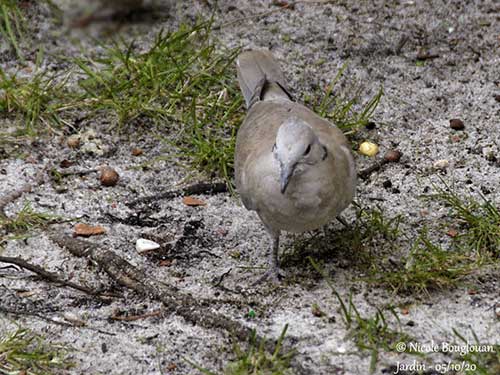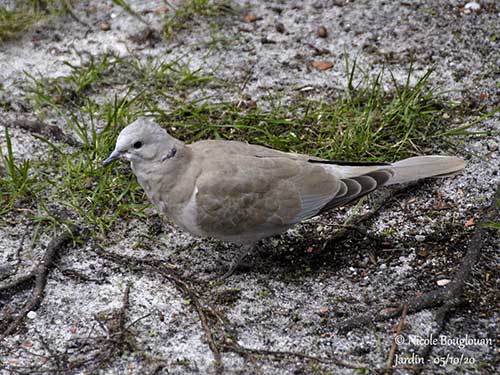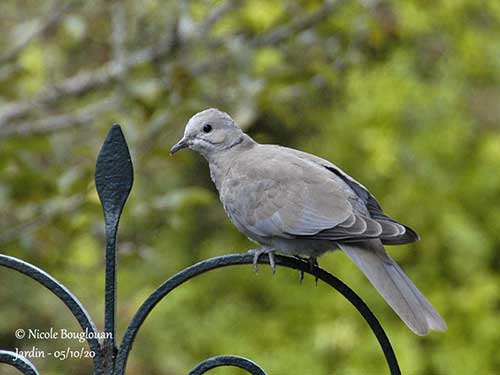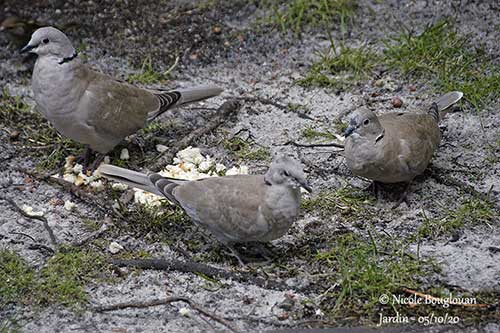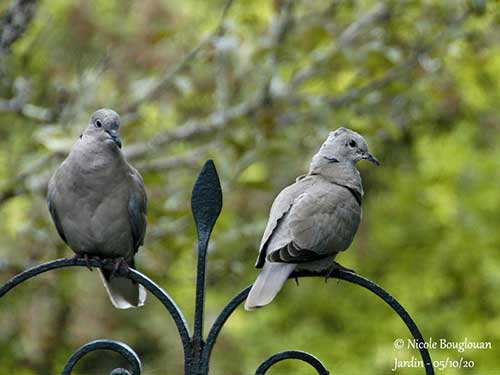
Text and pictures by Nicole Bouglouan
The text was written by Nicole Bouglouan, following an observation in the backyard, from late August to mid-September 2020.
All the pictures and the text of this page are owned by Nicole Bouglouan.
These images and the text are subject to copyright and cannot be used without express authorization from the owner. Legal issues
Sources:
PIGEONS AND DOVES by David Gibbs, Eustace Barnes and John Cox - Pica Press Sussex - ISBN: 1873403607
HANDBOOK OF THE BIRDS OF THE WORLD – Volume 4 by Josep del Hoyo-Andrew Elliott-Jordi Sargatal - Lynx Edicions - ISBN: 8487334229
Pour la Science - Le lait de pigeon
Wikipedia, the free encyclopaedia
Page under
copyright !
Reproduction of the Eurasian Collared Dove (Streptopelia decaocto) in the garden
From late August to mid-September 2020
The Eurasian Collared-Dove has been present in our garden for a very long time. Very comfortable within this area, they breed there several times each year for our greatest pleasure.
The species extended its range to all of Europe, Africa and North America during the 20th century. Some of this expansion has been natural, but in contrast, captive birds that escaped from a farm in the Bahamas in the 1970s, and whose remaining birds were eventually released, are responsible for its arrival in America.
Present in France since the 1950s, it is today one of the most widespread species in the countryside and even in towns.
Our pair settled into their favorite old chestnut tree, and the nest was built in a fork made up of several thin branches and surrounded by still green foliage at the end of August 2020. It is in the shade for most of the day, and the rest of the time, the few leaves present and judiciously placed protect the birds from the sun. It is placed 6-7 metres above the ground and is not easily visible even though it is in plain view in the courtyard of the house. The movements of the doves allowed us to locate it, and from that moment, to observe the behaviours of these elegant birds.

It was on August 24, 2020 that we saw the nest for the first time. Composed of crisscrossing twigs, the construction appears loose and fragile, a typical feature of Columbidae. In fact, this type of nest allows the rain to pass through without stagnating in the cup where eggs or chicks are located, depending on the period.
We have been worried a couple of times as there are twigs hanging below but nothing is moving. Upon closer inspection, we found that the weft remained stable and strong.
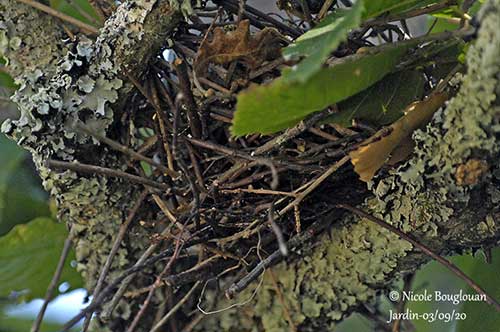
An adult was quietly incubating, undisturbed by our silent presence. However, its eyes were fixed on us, but it showed no sign of panic and continued the incubation which, in this species, lasts about two weeks. Not knowing when the eggs were laid, we can only wait until after.
New observation two days later, on August 26, an adult is still incubating while napping in the shade. Everything is calm and we leave it. The two adults take turns to incubate.
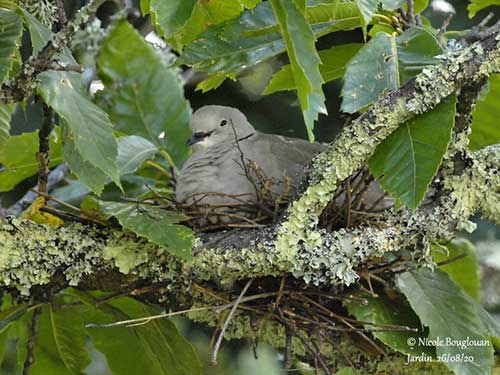
Same scenario on August 30. But looking closely, we see the bird a little restless. It looks up, but also under his body. Could this be a sign that something has moved in the nest? Mystery, we see nothing.
The other dove comes to the ground below the nest. It walks calmly towards us and flies off to land a little higher up. Maybe now is the time for change. We leave so as not to disturb them.
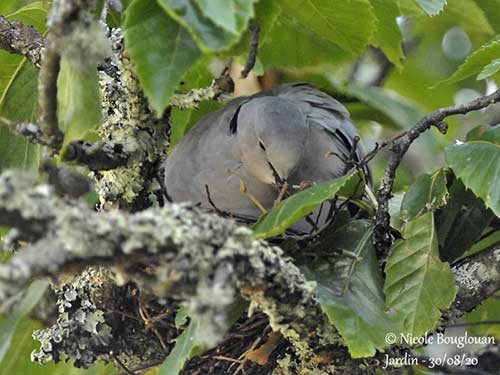
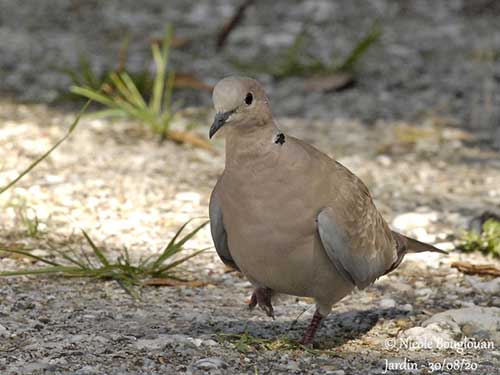
Quite by chance, I was able to witness the change of adults on the nest in the garden. The newcomer lands on a small branch above, and then, it descends branch by branch until it comes to rest on the rim of the nest, behind the incubating adult. It then leans forward as the incubator bird slowly slides out of the nest on the opposite side. The newcomer immediately settles down on the nest carefully. At no time was there any loss of heat. The change happened in silence.
Another day, the incubator adult momentarily left the nest to drink a few metres away. But a Eurasian Magpie began to chatter in the oak tree behind the chestnut tree, and therefore not far from the doves' nest. The one who was drinking came back immediately to the nest to protect the eggs.
The Eurasian Magpie is a well-known predator that steals both eggs and chicks of other birds, often to feed its own young.
A predator of doves, the Eurasian Sparrowhawk also passed over the oaks, pursued by Common Starlings. I clapped my hands and the raptor changed direction. I haven't seen him since.
On September 3, after checking again the solidity of the nest with a photo taken from below, we left the birds alone. The incubation did not appear to be over.
But looking at the photos taken that day, a white mark near the gape of the adult catches my attention ... The young must have been born because it is a residue of "crop milk" indicating that this bird has just fed its chicks. But they are not visible at the moment.
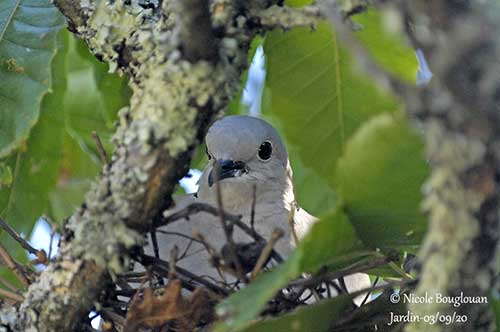
And September 7 gave us a good surprise. Our attention was caught by the arrival of one adult on the rim of the nest while the other flew away. But this time, it was no longer a question of incubating but of feeding!
As soon as the dove was placed on the nest, two chicks with yellowish down, but already with some feathers, literally threw themselves on it. Each on one side, but one after the other, they put their bill at the corner of that of the adult before pushing it completely into its bill, and it began to regurgitate the famous "crop milk. ". The feeding lasted well for two or three minutes during which the adult had no respite. When it wasn't one, it was the other who stung the corner of his bill.
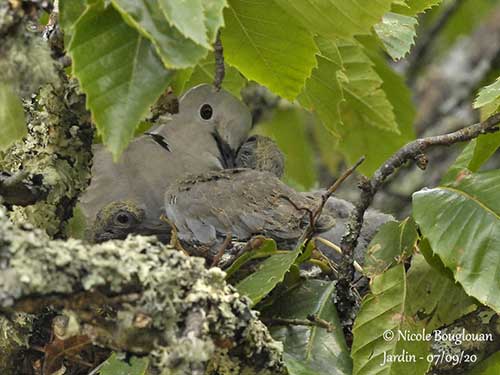
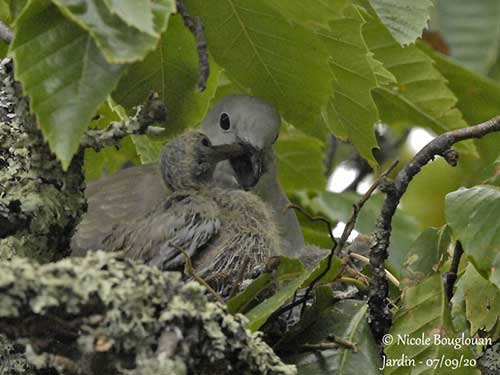
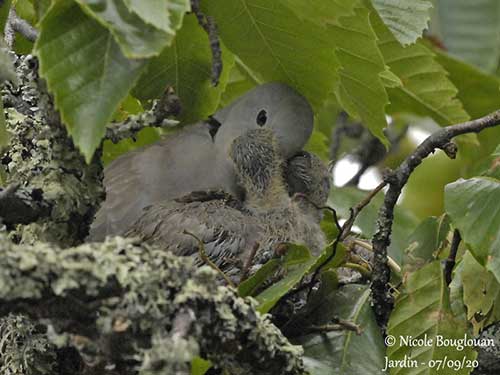
It seemed to be painful for the adult, but it gave all the food in no time! At the end of the session, a small thread of saliva still united the bill of a chick to that of the adult. But the young were full and they lay down next to their parent who finally rested.
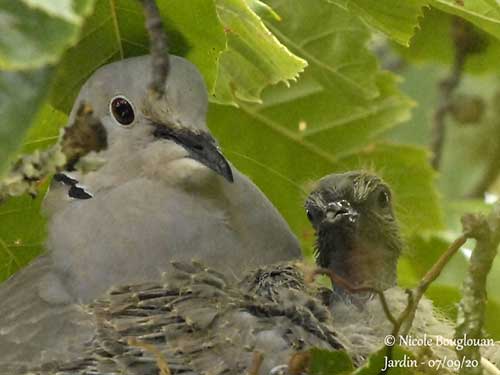

September 9th, just a quick glance to make sure all is well. An adult is on the nest and a chick is lying in front of him. The other does not appear and must be behind. In the evening, in order to check again if everyone was there, we only saw one young on the nest. We waited, but the other one didn't show up. Hoping nothing had happened to the chick, we decided to wait until the next day.
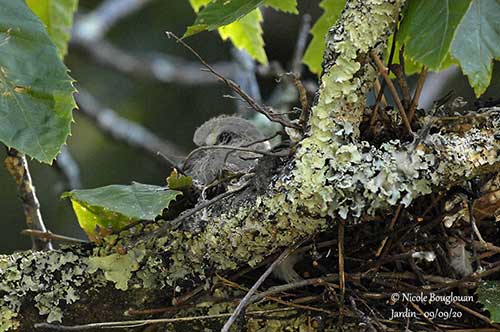
But the next day, September 10, we see the adult on the nest with both chicks. So, it's all right. They already have less down on the top of their heads and they look more confident.
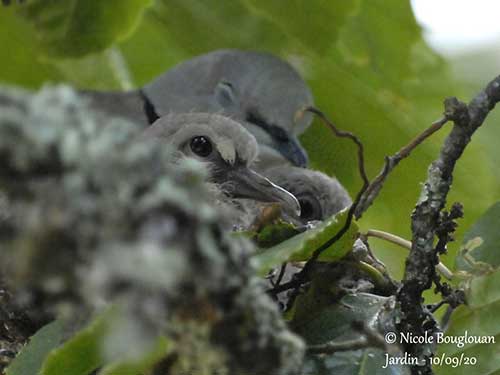
On September 11, they are both alone in the nest. It must be said that the place is starting to run out. In addition, the weather is very beautiful and they do not suffer from the cold, it would be rather the opposite because it is very hot in the afternoon.
The one who is to be the first born begins to wiggle and stretch its wings, pushing the second a little. But good relations seem to reign and the two young settle down side by side. These various contortions have enabled us to see again that the down gradually falls and gives way to feathers.
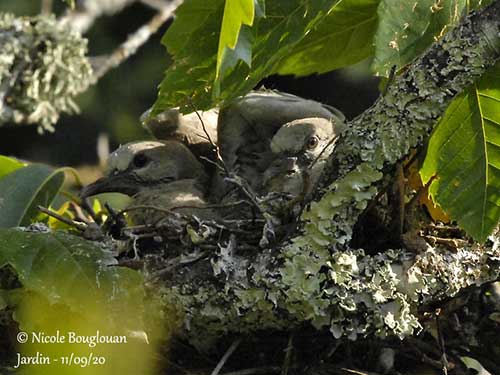
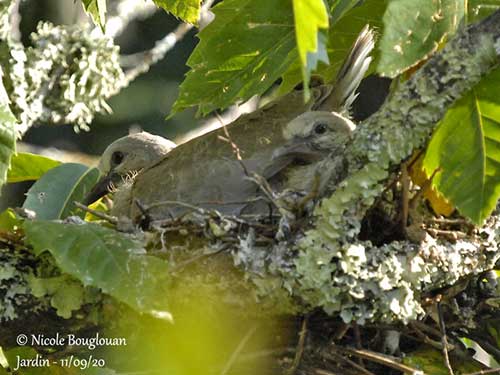
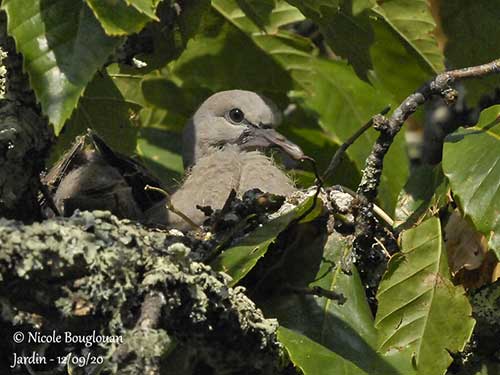
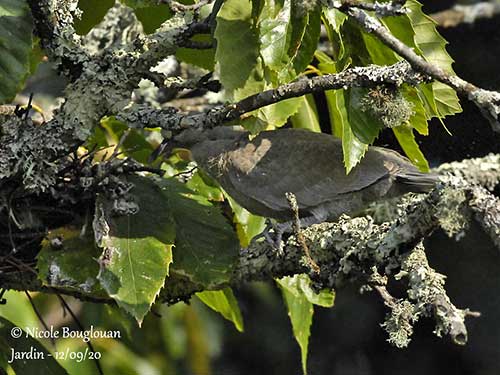
On September 13, the two young birds are lying side by side, back to the sun. One of them stretches its wings and legs well, which shows us that the wing feathers are well formed, but there is still some down on the sides.
A little later, they move again on the branch to protect themselves from the sun. One of them inflated the rump feathers to restore body temperature, while its bill opens and closes at a steady rate.
The second is installed on the other side on the rim of the nest and in the shade as well.
An adult came to feed and hydrate them around 6:30 p.m. and calm returned.
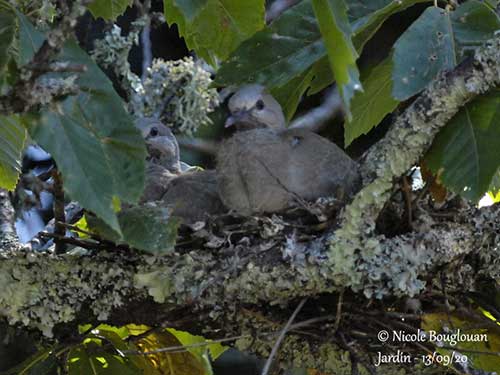
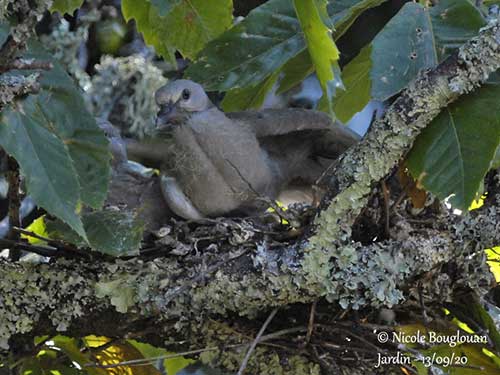
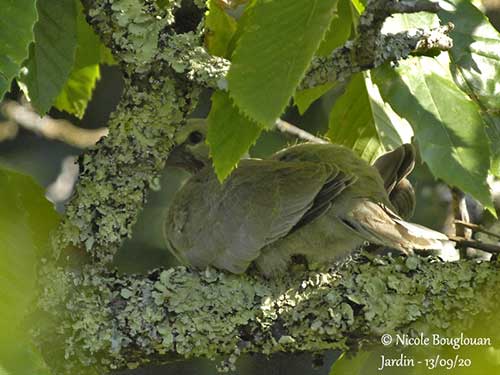
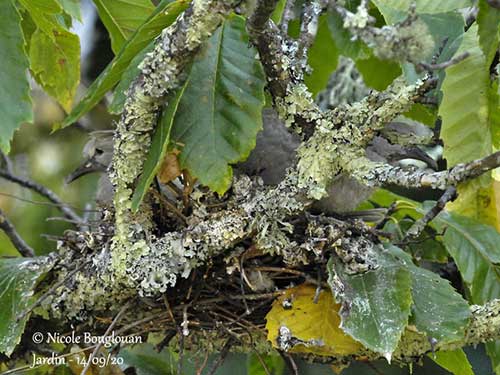
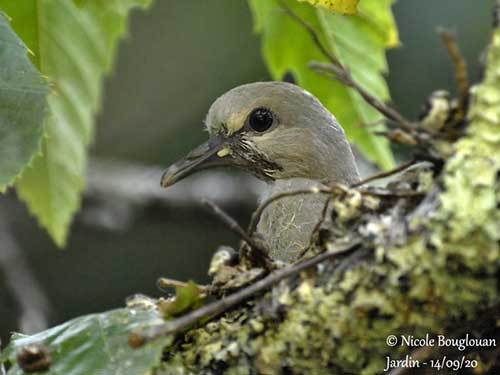

During the day, the parents are in the surroundings. They feed themselves to make this famous so nourishing milk, composed of proteins, lipids and a small amount of mineral salts. Male and female can produce it. Unlike milk produced by mammals, pigeon's milk does not contain carbohydrates. It contains 65 to 85% water, which explains the need to drink a while before regurgitating this substance despite everything quite thick. This milk is very nutritious and leads to rapid growth of the juveniles.
After three or four days of this rich diet, the young are fed a mixture of this milk and seeds for about 18 days before they are weaned and have access to normal food.
Early in the morning on September 15, there is only a young in the nest where an adult has come to feed it. No trace of the second yet. It probably managed to land in the nearby oaks and is therefore not visible.
On the nest, the youngest also tries its wings and wiggles, then suddenly jumps to the branch above its head and clings to it. This one also wants to leave the nest!
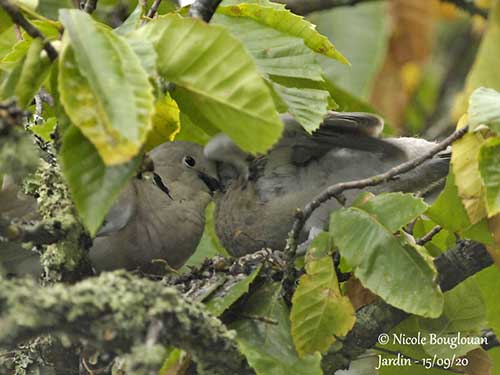
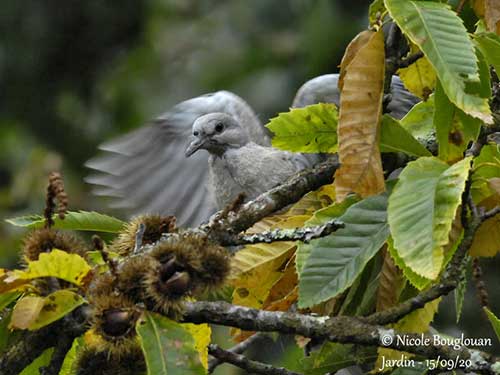

It is therefore quite clear that the feeding still takes place in the nest. Once sated, they stay a few moments on the nest, still trembling after this session. But as the space becomes smaller and smaller, one of them lands on the branch 30 centimeters away, to let more space for the youngest.
It is obvious that the two juveniles now want to look elsewhere, and they will no doubt very quickly reach the more protective oaks. They will be fed where they are, for a few more days.
If yesterday evening September 15 after feeding, the two juveniles were turned towards the oaks to go to sleep, this morning September 16, we heard the parents screaming while passing over the house, probably to announce breakfast. And indeed, the young were fed on the nest, jostling each other a bit.
Two hours later, one of them was on the branch next to the nest, but the other, the more awake, was not present.
Around 4 p.m. in the afternoon, an adult flew over the chestnut tree to call them, and this time they were fed on a large branch, about 2-3 meters from the nest. Apparently, behaviours are changing, and the nest will soon be just a remnant in the chestnut tree that is starting to lose its leaves.
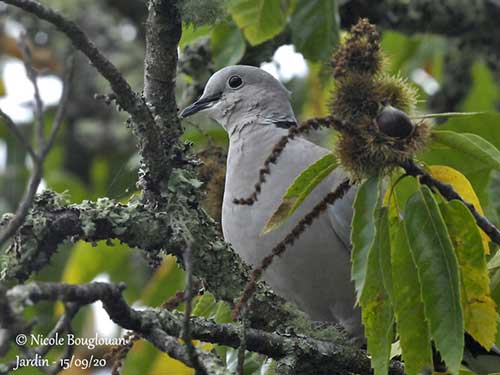
Today, September 17, our two young doves are sitting in the branches of the chestnut tree and waiting for the adults which are not far away. It's mealtime!
We notice that the black collar begins to appear on the bird at the top of the picture, which means it is about 17 days old. This age corresponds well to the behaviours that we have been lucky enough to observe.
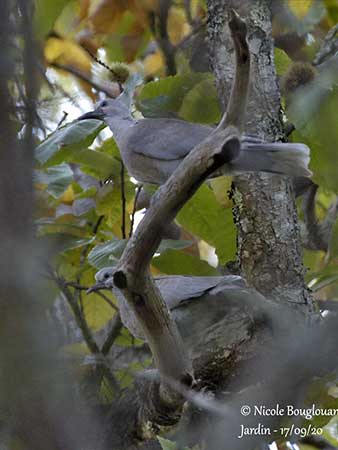
The pictures of the nest at the end of the cycle show a transparent but still solid cup, because it is made with rigid branches of a certain thickness. It is placed in a fork made up of several thin branches. These small branches allowed the juveniles to come out of the nest when it got too small. They were able to land there, rest there and stretch their wings without disturbing each other. In addition, the scattered foliage present in the right places has kept the nest in the shade for much of the day, except in the evening when the sun is lower.
The place has been well calculated for the well-being of both chicks and adults. And contrary to what many people say, it held on!
We can only wish good luck to these young nice doves who have everything to learn from nature, its predators (animals and humans) and the variations of the weather which, depending on the period, will provide them abundant food or not.

Latest information:
We saw the two juveniles again today October 4th. They are beautiful, a little thinner than the adults who seem to be weaning them. They were together at noon in front of crumbs of bread intended for the sparrows. The adults ate and the young too, but timidly. They stay very close to the bill of their parents !!! But the time to leave is approaching. They are about five weeks old.
LATEST IMAGES - OCTOBER 5th 2020
